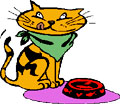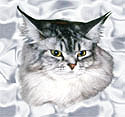Vol. 2, No. 15
Table of Contents
Feline Nutrition: Hup-Two-Three-Four
Assist Feeding: Spoil that Cat!
Kitty Potpourri: Tales of the Tongue
Best Cat Food: Cowboy Cookout
Caring for Cats: Proactive Plant: Step-11
Feline Nutrition
Hup-Two-Three-Four
by Garry White
Well, we probably won’t have much success getting Fluffy to march or jog everyday, but we do need to give special consideration to cats who are inactive; especially those with a good appetite. The reasons can vary, but mostly we see activity and playfulness decrease with age. Whatever the cause, we need to realize the importance of maintaining the ‘calories-in/calories-out’ ratio , same as we do with humans, and perhaps the best way to approach this is by looking at a few of the numbers first.
We’ve learned along the way that an average, 10-pound cat needs about 275 calories a day; an older kitty can sneak by with a few less than that, but we’ll use those numbers for reference. Ideally, we want the calories-in/calories-out ratio to be about zero, or slightly less. Two natural factors help to achieve this balance, but alone they aren’t enough: One is the Basic Metabolic Rate (BMR), which is the amount of calories burned just by being alive. Even lying down, a cat’s body will burn about 50-60% of caloric intake. Another factor is called Dietary Thermogenesis, which is the amount of calories burned in the process of eating, digesting, and using food; this accounts for about another 10% of caloric intake. So by living and eating, we’ve consumed about 70%, which leaves a deficit (about 82 calories per day) to deal with. Here are some practical ways Fluffy can burn up some of those remaining calories:
- Running 5 miles a day – 32.65 calories
- 2 hours of golf – 35 calories
- 30 minutes of Racquetball – 15 calories
- 1 hour of kissing – 5 calories
Okay, perhaps these aren’t so practical, but neither are most exercises we might dream up for Fluffy. Actually, the point of the silly references are to exemplify the obvious: Minor activity.having your kitty chase a toy mouse occasionally, or perhaps chase a string that you pull along for 5 minutes.will burn off a calorie or two, but does little in the overall scheme of things.
Gee, that’s quite a deficit, after all, isn’t it? It is, but there are things we can do to help, and we’ll begin with the knowledge that cats do not follow orders, including a well-designed exercise regimen. Phooey! So we have to out-think them, and forced exercise will probably offer the least success of all efforts. Logic being: We can’t order them to run around the living room a hundred times a day, and while an enclosed, outdoor pen would offer supreme benefits, it’s simply not a practical consideration for most of us. Which leaves us with food, eating habits, and perhaps natural (herbal) supplements (stimulants). I have no experience with the latter, but many folks swear they work. So, from a practical standpoint, I’m stuck with food and eating habits. As for eating habits: They say it’s possible to train a cat to eat smaller but more frequent portions, so as to decrease the total daily intake. I dunno. Personally, I think the greatest benefit comes from quality, holistic food that’s designed more for nutritional balance than for profit, and specifically foods that offer a goodly mix of vegetables and few carbohydrates. Another trick that seems to work is one I stole from human diet programs: Flavored juice instead of food, periodically. A cheap roast (or whole chicken, or even fish) in the crock-pot with some water.generates tons of juice, it’s good for them after you skim off some of the fat, and they really do eat less actual food.
Good luck, and if you have a trick or two up your sleeve that actually works, please let us know.
Assist Feeding
Spoil that Cat!
by Kathy Fatheree
Last week. Bert started developing a site infection. The clinic did a culture and it’s not a major infection so we don’t have to go with antibiotics. We are continuing to treat it with Neosporin and while it hasn’t completely gone away, it is improving. Thankgoodness antibiotics are not necessary. While antibiotics are often the quick fix, they can upset a kitty’s tummy and even their entire system… not something we want to take a chance on. Bert is doing so well that the topical skin treatment is a gentle, conservative approach.
Here’s a refreshing outlook on blood testing: Bert’s last blood work showed that his enzymes were only slightly elevated, however, Dr. Smith isn’t worried about constant testing. he said that the physical proof (how Bert is acting) shows that he’s doing better everyday. As our Garry has mentioned before, watching a cat’s body language is so very important in knowing how a kitty is feeling. You know your cat better than anyone!
Bert’s last blood work showed that his enzymes were only slightly elevated, however, Dr. Smith isn’t worried about constant testing. he said that the physical proof (how Bert is acting) shows that he’s doing better everyday. As our Garry has mentioned before, watching a cat’s body language is so very important in knowing how a kitty is feeling. You know your cat better than anyone!
Spoiling a sick cat and making him or her feel all the more special does fabulous things to self-esteem and an overall sense of well being. Extra special words and touches heal the body and mind. Take ’em wherever you can get ’em! All the vet techs at Dr. Smith’s office just fawn all over Bert. Two of the girls in particular seem to have developed an affection towards him. Bert just LOVES it! We get into the exam room and they come in and just rub him from head to toe cooing the whole time. He just eats it up!! Spoiled brat! 🙂
A Major Step Forward
We’re slowly reintroducing Bert’s hard food, which he’s doing really well with. He’s not interested in eating yet but the drooling has all but stopped and he doesn’t run when we set the bowl in front of him. In fact he just acts unimpressed. He’ll look at it, maybe sniff it and mosey away! We’re taking this as a good sign though, anything is better than the aversion! The problem is Bert LOVES his tube feedings. When he hears me getting his food ready he gets antsy! I’ll come into the bedroom with his syringes and boy he starts yelling! He’ll meow and meow and flop over purring. Dr. Smith said a small percentage of cats are hard to wean because they love it so much, lucky us Bert is one of those! It’s really funny actually; he’s such a piglet! Both Mitch and I have put a piece of hard food in his mouth but he’s swallowed it so quickly I don’t think he got the full effect of what it was. It’s a start though, however small!
Be Sure to Check in Next Week for the Latest on Bert!
Kitty Potpourri
Tales of the Tongue
by Dan Malenski
This week, we talk about the many roles our kitty’s tongue has and some of the finer details that many of us may not be aware of. We have Melissa to thank for obtaining much of this information from a very old Catnip© newsletter.
Cats have much greater taste sensitivity than we do, which might explain why kitty sometimes refuses to eat a particular item or balk at a change in diet. Their nose is responsible for getting them in the “ball park” of a delectable meal and is able to distinguish between subtle differences in odor, being that their nasal passages contain twice as much of smell sensitive cells (olfactory receptors) as ours. This sensitivity starts at birth, and a kitten is able to find its favorite nipple by its odor. While the nose plays an important role in luring kitty to its meal, the tongue does the real work of tasting. On the tongue’s surface are dozens of  lumps of tissue named papillae, each holding many clusters of taste-sensitive cells called taste buds. When food is in the cat’s mouth, the saliva dissolves some of its chemical components, sensed by the taste buds. The taste buds, have varying sensitivity to different chemicals, are then able to send a pattern of signals to the brain that enables the cat to distinguish taste.
lumps of tissue named papillae, each holding many clusters of taste-sensitive cells called taste buds. When food is in the cat’s mouth, the saliva dissolves some of its chemical components, sensed by the taste buds. The taste buds, have varying sensitivity to different chemicals, are then able to send a pattern of signals to the brain that enables the cat to distinguish taste.
The tongue being a receptacle for the taste buds is just one function of kitty’s multipurpose tongue! It also serves as a ladle for liquid, senses temperature and texture, and picks up small bits of food. It also directs traffic by insuring that its windpipe closes at the right moment so that the food goes down its esophagus. Muscles at the base of its tongue are critical for this function.
The best-known feature of the cat’s tongue is obviously its texture, which reminds one of a wire brush. Its raspy nature us caused by the presence of filiform papillae in the center of the tongue, curved forward and quite stiff. We all know how important this characteristic is in grooming but often forget how important it is for stripping the meat off the bones of prey, being that the vast majority of us have indoor cats as companions and feed them commercially prepared food. The only other animal that has a raspy tongue is the vegetarian cow and its near relatives, which is used for pulling up grass!
Aside from functional characteristics, the tongue also has a role in behavior. When a cat is grooming another animal or you if you are lucky enough, it is demonstrating its affection. If your cat is a “washer” and grooms you occasionally, do not take it as a cue to run off to the shower, but do understand that it is showing its love for you. My angel Mandy was a “washer” right from the time  when I adopted her as a kitten. Her first act when I met her was to “wash” my face, and later on in the early hours of every morning, she would jump upon the bed and nearly lick my face raw.
when I adopted her as a kitten. Her first act when I met her was to “wash” my face, and later on in the early hours of every morning, she would jump upon the bed and nearly lick my face raw.
There have been many studies performed regarding how cats respond to different tastes, but we will not discuss them now, as I am getting a stern look from the girls, warning me not to transform this week’s article into a cure for insomnia. However, I will mention one interesting item from this research; that is, the sensitivity that cats have to variations in water flavor. While we think of water being generally bland, cats have the ability to detect subtle differences in taste, which may explain why some prefer to drink water directly from a dripping faucet. Maybe they are telling us to change their water more often!
Best Cat Food
Cowboy Cookout
by Garry White
Each week we are having our own cat food reviews to determine what we, or should I say, our kitties think is the best cat food.

Brand Name: Merrick Pet Foods
Product: ‘Cowboy Cookout’
Type: Canned
Our Rating: ![]()
Kitty Rating: ![]()
Kitty Comments:
“That settles it; find me a Preacher-man. This is the best cat food. I’m gonna marry one-a-them Texas gals that sent this food!”
Our Comments:
“Clark, you are not! Besides, they’re probably already married. To Texans. Big Texans, most likely.you get the picture?” Poor boy’s in love, and it’s all because Diane Smith and Kay Roach from Merrick sent some samples for my guys to try. Disregard Clark’s matrimonial urgings, ladies; the gesture was appreciated. We tried the Cowboy Cookout, and needless to say, Clark and Wilbur both went crazy for it. To the readers: As always, I did my nutritional inquest before popping the top, and I’ll tell you straight away that this is excellent food! Beef, beef broth, and even beef liver (which we don’t see too often, eh?). There is the standard list of quality vegetables, of course, but something else stood out in particular: Granny Smith Apples. For those of you unfamiliar with this fruit, Granny Smith Apples started in England, and somehow found their way to Australia 140 years ago, where the strain has been nurtured and maintained ever since. Granny Smith Apples are the most sought-after by top chefs (and, incidentally, the most expensive) of any apple! I wondered why.an apple is an apple, right? Nope. These apples offer not only a unique type of calcium that just happens to be great for cats, but the blend of pectin and magnesium-phosphorous is unlike that found in just about any other apple! Talk about splitting hairs.these Merrick folks go the extra mile, huh?
I’ll leave you with this: Merrick offers a very cool package called the “Variety 8-Pack“, and I strongly recommend that you grab a couple of these. Your cats will love the foods, and you can take it from me that they are nutritionally okay! Hint: You might want to give Diane a call at the number below, and ask her to send you their ‘Five-Star Gourmet Menu for Cats’.
Manufacturer Says:
Well, let Clark know that one of us is married and one is not and we are not telling which is which. And it looks like Clark really liked it, as he rated Cowboy Cookout the BEST.
Here in the Lone Star State, we love beef as much as cats love to take naps. This meal combines the fine quality of human grade ingredients from the protein sources that we use as the number one ingredient to the fresh vegetables and fruits that we add to this Merrick special dish. If you read our ingredient panel, you will notice that we did not forget any of the details and that this meals is loaded with nutrition.
And Garry is right, the “Variety 8-Pack” is the spice of life and our family at Merrick would like to invite your cat on a journey of the senses. The Pack includes California Roll, Cowboy Cookout, Grammy’s Pot Pie, New England Boil, Southern Delight, Surf & Turf, Thanksgiving Day Dinner and Turducken.
Stay tuned and Garry will be sharing information on the other varieties.
The Merrick’s cats say “Howdy”.
Website: www.merrickpetcare.com
Phone: 1-800-664-7387

Caring for Cats
Proactive Plan: Step-11
by Garry White
Avoiding Toxic Poisoning
We’re surrounded daily by any number of things that are toxic to cats; the list goes on nearly to infinity. But the list of effective methods for avoiding toxic poisoning is short: Knowledge and common sense. Some of the more obvious risks are: Certain plants, cleansers, anti-freeze; things we’ve all heard a million times. A few obscure toxic traps include certain cooking spices, some carpet shampoos, even those nice-smelling dryer-sheets in the laundry room.
Again, the list is almost endless, and rather than try to identify every potential risk, I’m going to steer you to several good links that cover a vast array of toxic hazards. Browse through them, and pay particular attention to things that might exist in your household.
http://funkstownvet.com/toxicity.html
A great link that highlights many things we would never think of!
http://www.cats-and-kittens.com/toxic.htm
Thorough.easy to read and understand
http://www.vetinfo.com/ctoxin.html
Written by veterinarians.
Disclaimer: Kathy Fatheree is not at all a medical expert. Contents of this web site are a collection of Kathy’s assist feeding experiences as well as the experiences of other cat owners who have assist fed their cats. While every effort has been made to ensure the accuracy of the information, Kathy Fatheree or anyone associated with this web site cannot be held responsible for anything that may happen as a result of using the information on this site.
